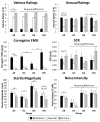Emotional modulation of pain and spinal nociception in fibromyalgia
- PMID: 23622762
- PMCID: PMC3679206
- DOI: 10.1016/j.pain.2013.03.025
Emotional modulation of pain and spinal nociception in fibromyalgia
Abstract
Fibromyalgia (FM) is characterized by widespread pain, as well as affective disturbance (eg, depression). Given that emotional processes are known to modulate pain, a disruption of emotion and emotional modulation of pain and nociception may contribute to FM. The present study used a well-validated affective picture-viewing paradigm to study emotional processing and emotional modulation of pain and spinal nociception. Participants were 18 individuals with FM, 18 individuals with rheumatoid arthritis (RA), and 19 healthy pain-free controls (HC). Mutilation, neutral, and erotic pictures were presented in 4 blocks; 2 blocks assessed only physiological-emotional reactions (ie, pleasure/arousal ratings, corrugator electromyography, startle modulation, skin conductance) in the absence of pain, and 2 blocks assessed emotional reactivity and emotional modulation of pain and the nociceptive flexion reflex (NFR, a physiological measure of spinal nociception) evoked by suprathreshold electric stimulations over the sural nerve. In general, mutilation pictures elicited displeasure, corrugator activity, subjective arousal, and sympathetic activation, whereas erotic pictures elicited pleasure, subjective arousal, and sympathetic activation. However, FM was associated with deficits in appetitive activation (eg, reduced pleasure/arousal to erotica). Moreover, emotional modulation of pain was observed in HC and RA, but not FM, even though all 3 groups evidenced modulation of NFR. Additionally, NFR thresholds were not lower in the FM group, indicating a lack of spinal sensitization. Together, these results suggest that FM is associated with a disruption of supraspinal processes associated with positive affect and emotional modulation of pain, but not brain-to-spinal cord circuitry that modulates spinal nociceptive processes.
Copyright © 2013 International Association for the Study of Pain. Published by Elsevier B.V. All rights reserved.
Figures





Similar articles
-
Emotional modulation of pain and spinal nociception in persons with major depressive disorder (MDD).Pain. 2013 Dec;154(12):2759-2768. doi: 10.1016/j.pain.2013.08.009. Epub 2013 Aug 15. Pain. 2013. PMID: 23954763 Free PMC article. Clinical Trial.
-
Affective disturbance associated with premenstrual dysphoric disorder does not disrupt emotional modulation of pain and spinal nociception.Pain. 2014 Oct;155(10):2144-52. doi: 10.1016/j.pain.2014.08.011. Epub 2014 Aug 17. Pain. 2014. PMID: 25139588
-
Examining emotional modulation of pain and spinal nociception in Native Americans: a preliminary investigation.Int J Psychophysiol. 2013 Nov;90(2):272-81. doi: 10.1016/j.ijpsycho.2013.08.009. Epub 2013 Aug 29. Int J Psychophysiol. 2013. PMID: 23994207
-
Biology and therapy of fibromyalgia: pain in fibromyalgia syndrome.Arthritis Res Ther. 2006;8(3):208. doi: 10.1186/ar1950. Epub 2006 Apr 24. Arthritis Res Ther. 2006. PMID: 16684376 Free PMC article. Review.
-
Fibromyalgia is associated with hypersensitivity but not with abnormal pain modulation: evidence from QST trials and spinal fMRI.Front Pain Res (Lausanne). 2023 Dec 5;4:1284103. doi: 10.3389/fpain.2023.1284103. eCollection 2023. Front Pain Res (Lausanne). 2023. PMID: 38116188 Free PMC article. Review.
Cited by
-
Algometry for the assessment of central sensitisation to pain in fibromyalgia patients: a systematic review.Ann Med. 2022 Dec;54(1):1403-1422. doi: 10.1080/07853890.2022.2075560. Ann Med. 2022. PMID: 35579545 Free PMC article.
-
Endogenous inhibition of pain and spinal nociception in women with premenstrual dysphoric disorder.J Pain Res. 2016 Feb 11;9:57-66. doi: 10.2147/JPR.S97109. eCollection 2016. J Pain Res. 2016. PMID: 26929663 Free PMC article.
-
Decreased Pain Perception by Unconscious Emotional Pictures.Front Psychol. 2016 Oct 21;7:1636. doi: 10.3389/fpsyg.2016.01636. eCollection 2016. Front Psychol. 2016. PMID: 27818642 Free PMC article.
-
Prevalence, Patterns, and Risk Factors of Work-Related Musculoskeletal Diseases Among Teachers in the Eastern Province, Saudi Arabia: A Community-Based Retrospective Cross-Sectional Survey.Cureus. 2022 Dec 4;14(12):e32178. doi: 10.7759/cureus.32178. eCollection 2022 Dec. Cureus. 2022. PMID: 36605065 Free PMC article.
-
Brain Correlates of Continuous Pain in Rheumatoid Arthritis as Measured by Pulsed Arterial Spin Labeling.Arthritis Care Res (Hoboken). 2019 Feb;71(2):308-318. doi: 10.1002/acr.23601. Arthritis Care Res (Hoboken). 2019. PMID: 29781581 Free PMC article.
References
-
- Ang DC, Chakr R, Mazzuca S, France CR, Steiner J, Stump T. Cognitive-behavioral therapy attenuates nociceptive responding in patients with fibromyalgia: a pilot study. Arthritis Care Res. 2010;62:618–623. - PubMed
-
- Apkarian AV, Bushnell MC, Treede R-D, Zubieta J-K. Human brain mechanisms of pain perception and regulation in health and disease. European Journal of Pain. 2005;9:463–484. - PubMed
-
- Ardic F, Toraman F. Psychological Dimensions of Pain in Patients with Rheumatoid Arthritis, Fibromyalgia Syndrome, and Chronic Low Back Pain. Journal of Musculoskeletal Pain. 2002;10:19.
-
- Banic B, Petersen-Felix S, Andersen OK, Radanov BP, Villiger PM, Arendt-Nielsen L, Curatolo M. Evidence for spinal cord hypersensitivity in chronic pain after whiplash injury and in fibromyalgia. Pain. 2004;107:7–15. - PubMed
-
- Bartley EJ, Rhudy JL, Williams AE. Experimental assessment of affective processing in fibromyalgia. J Pain. 2009;10:1151–1160. - PubMed
Publication types
MeSH terms
Grants and funding
LinkOut - more resources
Full Text Sources
Other Literature Sources
Medical

